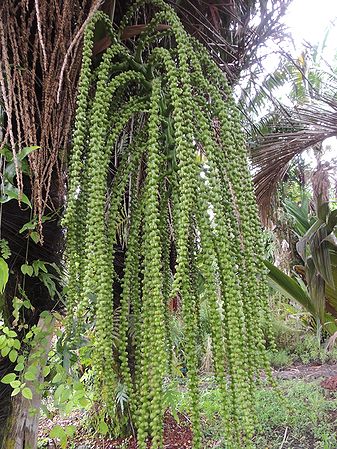Pronunciation: uh-RENG-uh pin-NAH-tuh
Common Name: Sugar Palm
Arenga pinnata is an enormous, pinnate palm from the Philippines, Sumatra, Vietnam and Indosesia which has some decent cold tolerance far beyond that needed to survive in its native lands. Good palm for low-wind coastal areas where there is plenty of room. Best to plant near vehicular access since it is a relatively short-lived, monocapric species that will likely require a crane to remove once it dies. Well grown specimens are extremely ornamental and awe-inspiring.
|
Appearance and Biology
- Habit: solitary
- Height: 50 feet
- Trunk: single, 1' thick and covered with fibrous matte and 1'+ long, thin but not very strong or sharp spines that radiate outward and upward
- Spread: 15'-25'
- Leaf description: pinnate, very long, upright-oriented, slightly plumose leaves with dark green, premorse, closely spaced leaflets about 2'-3' long; undersides silvery; leaf shape a wide 'V' in cross section (not flat); new leaves open a rust coloration
- Petiole: 12"-18" and well rounded with flattish dorsal surface; nearly 2" in diameter
- Reproduction: monoecious and monocarpic
- Inflorescence: short stem but long arching branches, arising from bases of lower leaves first, and working way up to top of palm; palm dies after top-most infructescence matures; flowers dark purplish and hang like heavy, densely beaded ropes
- Fruit: deep green to yellow as ripen; fruits 5-8cm and spherical; toxic oxalates
- Seed: 3cm and spherical
|
Horticultural Characteristics
- Minimum Temp: 28F
- Drought Tolerance: poor
- Dry Heat Tolerance: moderate
- Wind Tolerance: poor
- Salt Tolerance: poor
- Growth Rate: moderate to fast with age
- Soil Preference: moist and rich/ well draining, but somewhat tolerant of clay soils
- Light Requirement: full sun
- Human Hazards: toxic fruits; spines mildly dangerous- more to eyes than skin; leaves very heavy- careful below when pruning
- Disease or Horticultural Problems: relatively short-lived; looks ratty in windy climates and even worse if low humidity winds
- Indoor?: poor choice due to size, light requirements and rough, scratchy foliage
- Transplanting: unknown, but suspect low tolerance
|



















